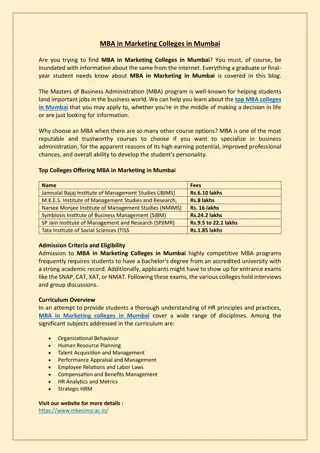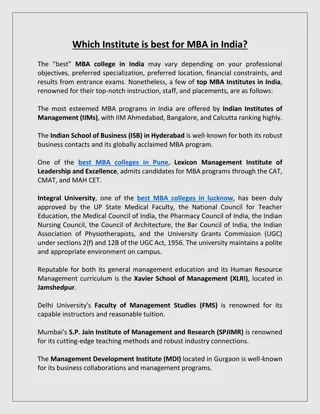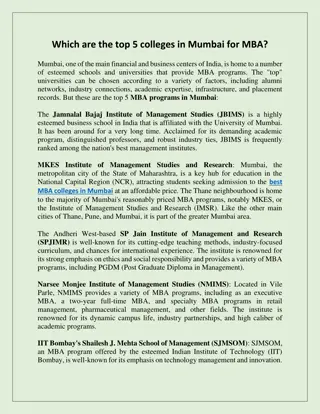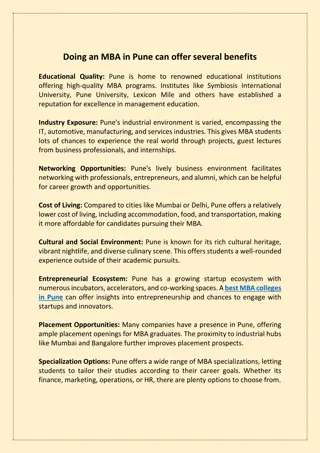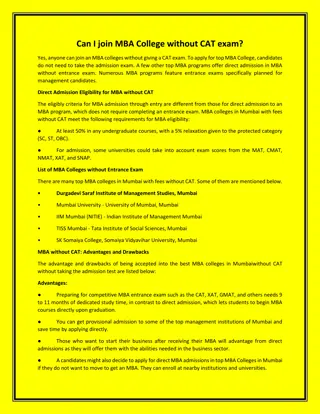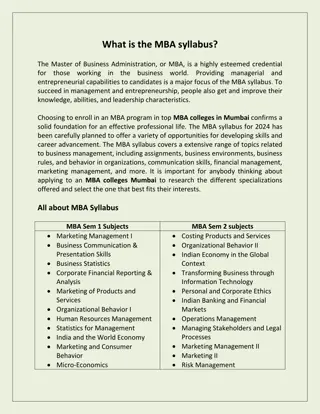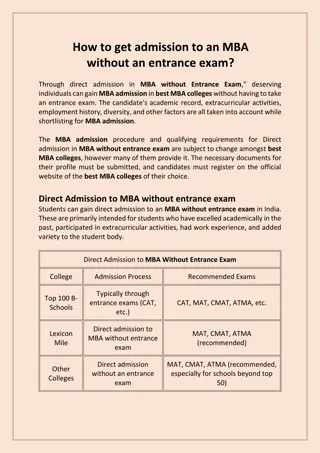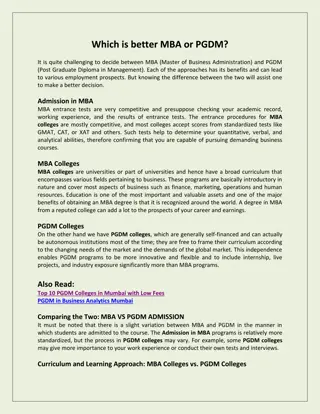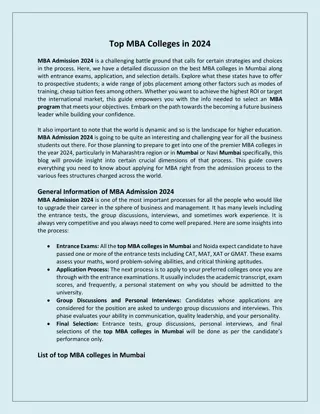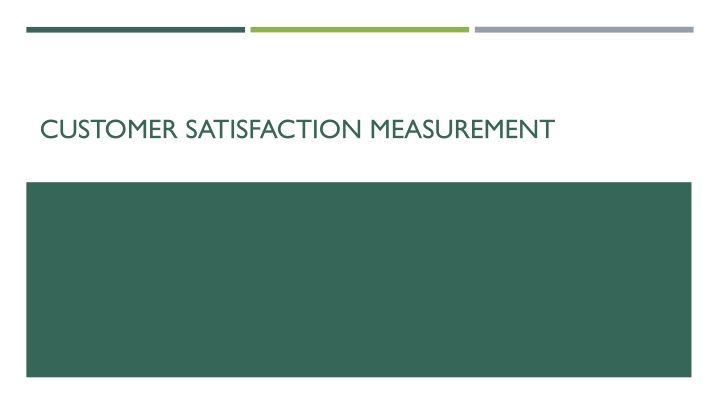
Importance of Customer Satisfaction Measurement for Business Success
Understanding the significance of measuring customer satisfaction is vital for business growth. It helps in improving customer retention, gaining a competitive edge, and enhancing products and services. By utilizing methods like surveys and feedback, businesses can boost customer loyalty and stay ahead of competitors.
Download Presentation

Please find below an Image/Link to download the presentation.
The content on the website is provided AS IS for your information and personal use only. It may not be sold, licensed, or shared on other websites without obtaining consent from the author. If you encounter any issues during the download, it is possible that the publisher has removed the file from their server.
You are allowed to download the files provided on this website for personal or commercial use, subject to the condition that they are used lawfully. All files are the property of their respective owners.
The content on the website is provided AS IS for your information and personal use only. It may not be sold, licensed, or shared on other websites without obtaining consent from the author.
E N D
Presentation Transcript
INTRODUCTION TO CUSTOMER SATISFACTION Customer Satisfaction (CSAT): A measure of how well a company s products, services, or overall experience meet or exceed customer expectations. It reflects the customer s perception of their experience with a brand,whether it be purchasing,customer service,or the product itself. Importance of CSAT: Customer Loyalty:Satisfied customers are more likely to return and make repeat purchases.This is critical for businesses that rely on customer retention. Brand Advocacy: Happy customers are more likely to recommend your business to others, leading to organic growth via word-of-mouth marketing. Competitive Edge: Companies with higher satisfaction rates can differentiate themselves from competitors,gaining an edge in a crowded market.
IMPORTANCE OF MEASURING CUSTOMER SATISFACTION Customer Retention: Measuring customer satisfaction helps you identify potential issues that could lead to customer churn (i.e.,customers leaving for competitors).Addressing problems early can increase retention rates. Example: A telecommunications company measuring satisfaction regularly might discover that slow response times on support tickets are causing dissatisfaction,prompting them to improve this process. Improving Products and Services: Feedback allows you to continuously improve your offerings.Even small changes,based on insights from CSAT,can lead to better customer experiences. Example: A software company may use customer feedback to make usability improvements in their interface,leading to a better user experience.
IMPORTANCE OF MEASURING CUSTOMER SATISFACTION CompetitiveAdvantage: Regular satisfaction measurement helps you stay ahead of competitors by responding to customer needs and keeping track of market expectations. Example: A hotel chain could use satisfaction surveys to fine-tune its services, offering better amenities or more personalized customer service than competitors . Real-TimeAction: Immediate feedback can enable businesses to act quickly and resolve issues before they escalate. Example:A retailer noticing that a particular product category consistently receives low satisfaction ratings might remove it from sale,investigate the issues,and improve or replace it. Customer Loyalty: Measuring satisfaction over time helps businesses track their success in keeping customers happy, which is directly correlated with customer loyalty and lifetime value. Example: A brand like Amazon uses surveys and data analysis to measure customer satisfaction continuously, which contributes to customer loyalty and retention.
COMMON METHODS OF MEASURING CUSTOMER SATISFACTION 1.Surveys & Questionnaires: Customer Satisfaction Survey (CSAT): Typically,a 1-to-5 scale (or 1-to-10) asking customers how satisfied they are with a product or service. Example Question:"How satisfied are you with our service today?" Pros:Easy to administer and analyze;provides clear,quantitative data. Cons:Doesn t capture qualitative feedback unless paired with open-ended questions. Net Promoter Score (NPS): Asks one simple question:"On a scale of 0 to 10,how likely are you to recommend our product/service to a friend or colleague?" Formula:NPS = %Promoters (9-10) %Detractors (0-6). Pros:Predicts customer loyalty and overall satisfaction;highly effective for benchmarking. Cons:Doesn't always explain why customers gave a particular score. Customer Effort Score (CES): Measures how easy it was for a customer to get their problem solved or complete a transaction. Example Question:"How easy was it to resolve your issue today?" Pros:Focuses on customer friction,which can lead to actionable insights on improving service processes. Cons:May not reflect the broader customer experience,as it focuses only on specific interactions.
COMMON METHODS OF MEASURING CUSTOMER SATISFACTION Interviews & Focus Groups: Allows for deep qualitative feedback. In-depth interviews or group discussions can reveal insights that simple surveys can't. Pros: Provides rich insights into customer thoughts, feelings, and pain points. Cons: Time-consuming and harder to scale. Online Reviews & Social Media Monitoring: Tracking customer feedback via review platforms (e.g., Google Reviews, Trustpilot) and social media mentions. Pros: Provides unsolicited, organic feedback. Cons: Reviews might be biased, and sentiment analysis can be difficult to interpret. Customer Feedback Forms: Feedback forms are often embedded into websites, apps, or after transactions (e.g., "How did we do today?"). Pros: Provides real-time feedback and captures sentiment right after the interaction. Cons: Can be ignored or skipped by customers.
KEY METRICS FOR CUSTOMER SATISFACTION Customer Satisfaction Score (CSAT): Formula: How to Use: This metric reflects immediate satisfaction after an interaction or purchase. Example: If 80 out of 100 survey respondents are satisfied, CSAT = 80%.
2. Net Promoter Score (NPS): Formula: How to Use: A high NPS indicates strong loyalty, while a low score signals dissatisfaction or potential churn. Example: If 60% of customers give a score of 9-10 (Promoters) and 20% give a score of 0-6 (Detractors), the NPS would be 40%.
Customer Effort Score (CES): Formula: How to Use: A lower CES indicates that customers are not experiencing significant friction when interacting with your company. Example: A CES of 3.2 (on a scale of 1 to 5) would indicate moderate effort, suggesting room for improvement in your customer support process.
Churn Rate: Formula: How to Use: High churn rates signal that customers are not satisfied enough to remain with your company.
Customer Retention Rate: Formula: How to Use: Measures how effective a company is in keeping its existing customers happy over time.
TOOLS AND TECHNOLOGIES FOR MEASURING CUSTOMER SATISFACTION 1. Survey Tools: SurveyMonkey: Customizable surveys, with advanced features like branching logic and data analysis tools. Google Forms: Simple, free tool for quick feedback collection. 2. Customer Feedback Platforms: Zendesk: Provides in-built tools for measuring CSAT after customer service interactions. Qualtrics: Advanced survey tool for measuring satisfaction, NPS, CES, and analyzing feedback across multiple touchpoints. 3. Social Media Monitoring: Hootsuite or Sprout Social: Helps track customer sentiment by monitoring social media conversations and reviews in real-time. 4. Review Aggregators: Trustpilot and Yelp: Aggregate customer reviews, providing an ongoing stream of feedback from real-world customers.
INTERPRETING CUSTOMER SATISFACTION DATA 1. Identify Trends: Look for recurring themes in feedback. For example, if multiple customers mention slow response times, it's a clear sign of a problem. 2. Actionable Insights: Example: If customers consistently rate your product 3/5 for quality, it s time to evaluate and enhance product quality. 3. Segmentation: Break data into segments (e.g., by product type, customer demographics) to understand specific needs. Example: NPS might differ significantly by region or product category. 4. Benchmarking: Compare your CSAT or NPS scores against industry standards to assess your performance. 5. Follow-Up: Actively follow up on negative feedback to show customers you're listening and improving. Example: Use negative NPS responses to reach out and resolve specific issues.
BEST PRACTICES IN MEASURING CUSTOMER SATISFACTION 1. Keep Surveys Short and Focused: Tip: Use a combination of multiple-choice and open-ended questions for both quantitative and qualitative insights. 2. Make It Easy to Provide Feedback: Place surveys at convenient touchpoints, like after a purchase or customer service interaction. Example: Amazon asks for feedback immediately after an order is fulfilled. 3. Time It Right: Don t overwhelm customers with surveys at every touchpoint. Choose strategic moments for feedback. 4. Act on the Feedback: Share results with your team and develop an action plan for improvement. 5. Ensure Anonymity: Customers will be more open to providing honest feedback if they know it s anonymous. 6. Monitor Continuously: Regular measurement provides ongoing insights rather than a single snapshot of customer sentiment.


